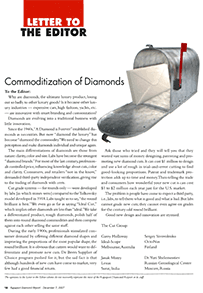|
Rapaport Diamond Report December 7, 2007
 Why are diamonds - the ultimate luxury product - losing out so badly to other luxury goods? Is it because other luxury industries (expensive cars, high fashion, yachts, etc,) are innovative with smart branding and customization? Why are diamonds - the ultimate luxury product - losing out so badly to other luxury goods? Is it because other luxury industries (expensive cars, high fashion, yachts, etc,) are innovative with smart branding and customization?
Diamonds are evolving into a traditional business with little innovation.
Since the 1940's "A Diamond is Forever" established diamonds as necessities. But now "diamond the luxury" has become "diamond the commodity". We need to change this perception and make diamonds individual and unique again.
The main differentiation of diamonds are those from nature; clarity, colour and size. Labs have become the strongest "diamond brands". For most of the last century, professionals controlled price influencing knowledge about cuts, colour and clarity. Consumers, and retailers ‘not in the know', demanded third party independent verification giving rise to the trading of diamonds with cert's.
Cut grade systems were developed by lab's (for rounds only) compared to the Tolkowsky model developed in 1918. Lab's taught us to say "the round brilliant is best", we even go as far as saying "Ideal Cut" which implying other diamonds are less than "ideal". We take a differentiated product, rough diamonds, polish half of them into round diamond commodities, and then compete against each other selling the same stuff.
During the early 1900's professional's stimulated consumer demand by offering different diamond shapes and improving the proportions of the most popular shape, the round brilliant. It is obvious that cutters would want to differentiate and promote new cuts. De Beers Supplier of Choice program pushed for it, but the sad fact is that although hundreds of new cuts have come to market, very few had a good financial return.
Ask those who tried and they will tell you that they wasted vast sums of money designing, patenting and promoting new diamond cuts. It can cost $1 Million to design and use a lot of rough in trial and error cutting to find good looking proportions. Patent and trade mark protection adds up to time and money. Then telling the trade and consumers how wonderful your new cut is can cost $1-2 Million each year just for the US market.
The problem is people have come to expect a third party, i.e. lab's, to tell them what is good and what is bad. But lab's cannot grade new cuts, they cannot even agree on grades for the century old round brilliant.
Good new design and innovation are stymied.
The Cut Group:
Garry Holloway, Ideal-Scope, Melbourne, Australia
Sergey Sivovolenko, OctoNus, Finland
Janak Mistry, Lexus, Surat, India
Dr Yuri Shelementiev, Russian Gemmological Center, Moscow, Russia
|




















